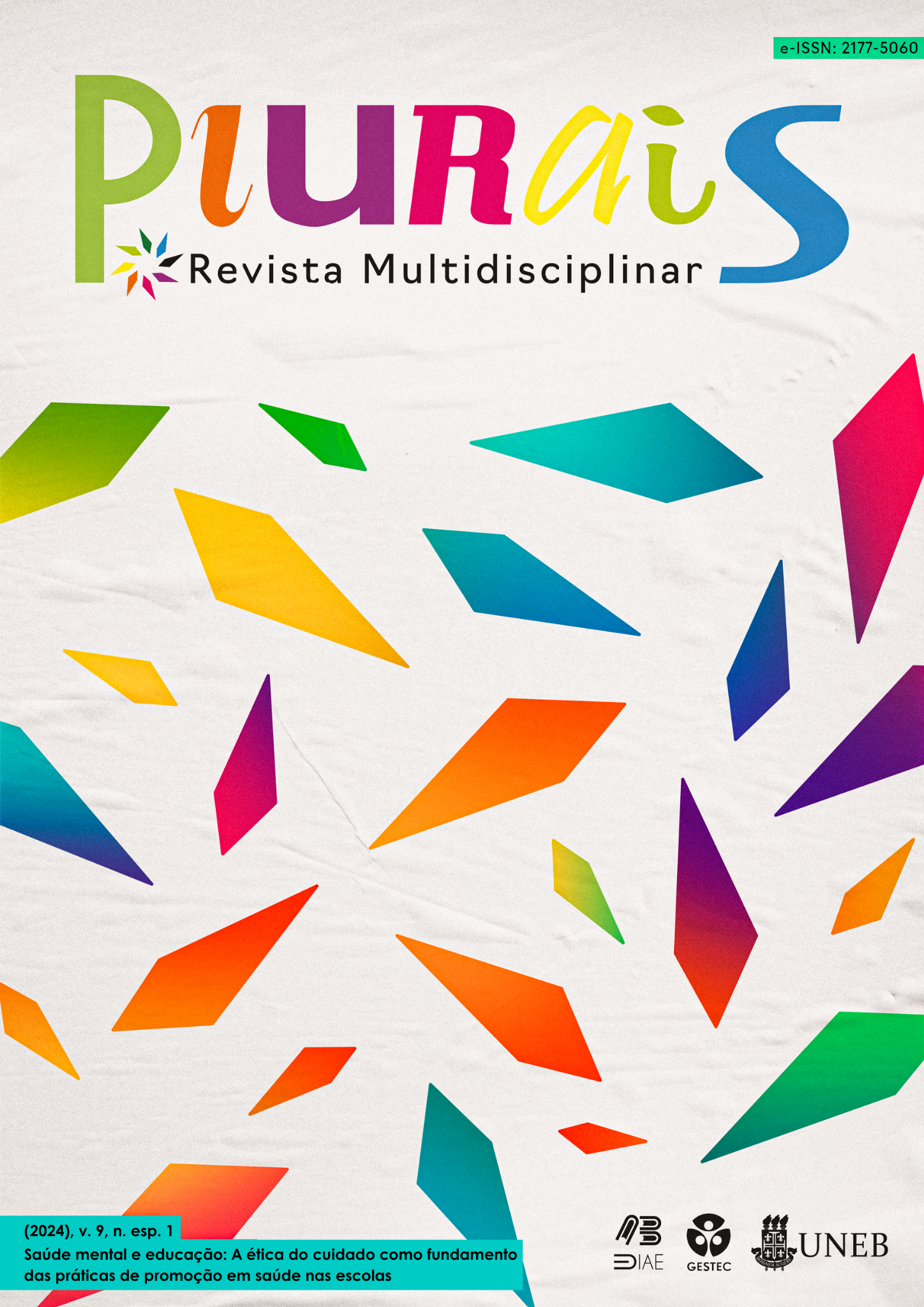Prevalence of Common Mental Disorder (CMD) and factors associated with the health of university students after social distancing in the COVID-19 pandemic
DOI:
https://doi.org/10.29378/plurais.v9iesp.1.19406Keywords:
Common Mental Disorder, College students, Associated Factors, COVID-19Abstract
The objective was to investigate the prevalence of Common Mental Disorder and its relationship with factors associated with the health of university students after social distancing in the COVID-19 pandemic. This is a cross-sectional study, at two universities in Fortaleza-CE, Brazil. 358 university students from health sciences and technology centers participated. Multiple logistic regression was applied using SPSS Statistic. The prevalence of CMD was 59.3% and was related to age <25 years (OR=2.18; p=0.029), poor self-rated health (OR=4.29; p<0.001), smoking (OR=3.02; p=0.028), cell phone dependence (OR=3.10; p<0.001), poor sleep quality (OR=3.92; p<0.001), musculoskeletal pain in the shoulder (OR=2.46; p=0.001) and elbow (OR=2.96; p=0.012). A high prevalence of CMD and its association with multiple health-related factors was found.
Downloads
References
AL-KHANI, Abdullah Murhaf et al. A cross-sectional survey on sleep quality, mental health, and academic performance among medical students in Saudi Arabia. BMC Research Notes, [S. l.], v. 12, n. 1, p. 665, 2019. DOI: 10.1186/s13104-019-4713-2.
ALMEIDA, Larissa; BARBOSA, De Oliveira; AVENA, Kátia De Miranda. Prevalence of common mental disorders among medical students during the Covid-19 pandemic. Revista Brasileira de Educação Médica, [S. l.], v. 46, n. 1, p. 1–9, 2022. DOI: 10.1590/1981-5271v46.1-20210242.ING.
BERG, Carla. et al. The impact and relevance of tobacco control research in low-and middle-income countries globally and to the US. Addictive Behaviors, [S. l.], v. 87, p. 162–168, 2018. DOI: 10.1016/j.addbeh.2018.07.012.
BERTOLAZI, Alessandra Naimaier et al. Validation of the Brazilian Portuguese version of the Pittsburgh Sleep Quality Index. Sleep Medicine, [S. l.], v. 12, n. 1, p. 70–75, 2011. DOI: 10.1016/j.sleep.2010.04.020.
CALLOU FILHO, Cesario Rui. Impacto do smartphone na disfunção musculoesquelética do pescoço em adultos. 2021. 120 f. Tese (Doutorado em Saúde Coletiva) - Universidade de Fortaleza, Fortaleza 2021.
CAO, Wenjun et al. The psychological impact of the COVID-19 epidemic on college students in China. Psychiatry Research, [S. l.], v. 287, p. 112934, 2020. DOI: 10.1016/j.psychres.2020.112934.
CARLOS, Jean et al. Autopercepção de saúde negativa e fatores associados em estudantes de uma universidade do oeste catarinense. Saúde (Santa Maria), [S. l.], v. 49, n. 2, e74481, 2023. DOI: 10.5902/2236583474481.
CETIC; BR, Núcleo de Informação e Coordenação do Ponto. Painel TIC Covid-19. Painel TIC COVID-19, [S. l.], v. 1, p. 1–28, 2022.
COUTO, Edvaldo Souza; COUTO, Edilece Souza; CRUZ, Ingrid de Magalhães Porto. #Fiqueemcasa: Educação Na Pandemia Da Covid-19. Interfaces Científicas - Educação, [S. l.], v. 8, n. 3, p. 200–217, 2020. DOI: 10.17564/2316-3828.2020v8n3p200-217.
DEBOWSKA, Agata et al. A repeated cross-sectional survey assessing university students’ stress, depression, anxiety, and suicidality in the early stages of the COVID-19 pandemic in Poland. Psychological Medicine, [S. l.], v. 52, n. 15, p. 3744–3747, 2022. DOI: 10.1017/S003329172000392X.
DU, Chen et al. Health Behaviors of Higher Education Students from 7 Countries: Poorer Sleep Quality during the COVID-19 Pandemic Predicts Higher Dietary Risk. Clocks & sleep, [S. l.], v. 3, n. 1, p. 12–30, 2021. DOI: 10.3390/clockssleep3010002.
ELEFTHERIOU, Anna et al. Sleep Quality and Mental Health of Medical Students in Greece During the COVID-19 Pandemic. Frontiers in Public Health, [S. l.], v. 9, p. 1–8, 2021. DOI: 10.3389/fpubh.2021.775374.
FISCHER-GROTE, Linda; KOTHGASSNER, Oswald; FELNHOFER, Anna. Risk factors for problematic smartphone use in children and adolescents: a review of existing literature. Neuropsychiatrie, [S. l.], v. 33, n. 4, p. 179–190, 2019. DOI: 10.1007/s40211-019-00319-8.
FRANCO, Dayana Chaves et al. Validade das medidas do tempo sentado do questionário IPAQ-versão curta em universitários brasileiros. Revista Brasileira de Atividade Física & Saúde, [S. l.], v. 26, p. 1–9, 2021. DOI: 10.12820/rbafs.26e0223.
GRANT, Jon; LUST, Katherine; CHAMBERLAIN, Samuel. Problematic smartphone use associated with greater alcohol consumption, mental health issues, poorer academic performance, and impulsivity. Journal of Behavioral Addictions, [S. l.], v. 8, n. 2, p. 335–342, 2019. DOI: 10.1556/2006.8.2019.32.
IBGE. Instituto Brasileiro de Geografia e Estatística. PNS - Pesquisa Nacional de Saúde. [S. l.], 2019. Disponível em: https://www.ibge.gov.br/estatisticas/sociais/saude/9160-pesquisa-nacional-de-saude.html. Acesso em: 10 set. 2023.
KAPAROUNAKI, Chrysi. et al. University students’ mental health amidst the COVID-19 quarantine in Greece. Psychiatry Research, [S. l.], v. 290, p. 113111, 2020. DOI: 10.1016/j.psychres.2020.113111.
KHOURY, Julia Machado et al. Assessment of the accuracy of a new tool for the screening of smartphone addiction. PLoS ONE, [S. l.], v. 12, n. 5, p. 1–13, 2017. DOI: 10.1371/journal.pone.0176924.
KIM, Hyunjeong et al. Association between Smartphone Usage and Mental Health in South Korean Adolescents: The 2017 Korea Youth Risk Behavior Web-Based Survey. Korean Journal of Family Medicine, [S. l.], v. 41, n. 2, p. 98–104, 2020. DOI: 10.4082/kjfm.18.0108.
KÖRMENDI, Attila. [Smartphone usage among adolescents]. Psychiatria Hungarica : A Magyar Pszichiatriai Tarsasag tudomanyos folyoirata, [S. l.], v. 30, n. 3, p. 297–302, 2015.
LOPES, Marcélia Célia Couteiro et al. Relationship between depressive symptoms, burnout, job satisfaction and patient safety culture among workers at a university hospital in the Brazilian Amazon region: cross-sectional study with structural equation modeling. Sao Paulo Medical Journal, [S. l.], v. 140, n. 3, p. 412–421, 2022. DOI: 10.1590/1516-3180.2021.0614.15092021.
MARTINS, Gilberto de Andrade. Estatística geral e aplicada: revisada e ampliada. São Paulo: Atlas Editora, 2010.
MATSUDO, Sandra et al. Questionário Internacional De Atividade Física (Ipaq): Estupo De Validade E Reprodutibilidade No Brasil. Revista Brasileira de Atividade Física & Saúde, [S. l.], v. 6, n. 2, p. 5–18, 2001. DOI: 10.12820/rbafs.v.6n2p5-18.
MCLAFFERTY, Margaret et al. Mental health, behavioural problems and treatment seeking among students commencing university in Northern Ireland. PLoS ONE, [S. l.], v. 12, n. 12, p. 1–14, 2017. DOI: 10.1371/journal.pone.0188785.
MORAES, Ramona Sant’Ana Maggi de et al. Iniquidades sociais na prevalência de desordens mentais comuns em adultos: Estudo de base populacional no Sul do Brasil. Revista Brasileira de Epidemiologia, [S. l.], v. 20, n. 1, p. 43–56, 2017. DOI: 10.1590/1980-5497201700010004.
MOTA, Daniela Cristina Belchior et al. Mental health and internet use by university students: Coping strategies in the context of covid-19. Ciencia e Saude Coletiva, [S. l.], v. 26, n. 6, p. 2159–2170, 2021. DOI: 10.1590/1413-81232021266.44142020.
NISHIDA, Tomoko; TAMURA, Haruka; SAKAKIBARA, Hisataka. The association of smartphone use and depression in Japanese adolescents. Psychiatry Research, [s. l.], vol. 273, n. November 2018, p. 523–527, 2019. Disponível em: 10.1016/j.psychres.2019.01.074.
OLIVEIRA, Elias Barbosa de et al. Common mental disorders in nursing students of the professionalizing cycle. Revista Brasileira de Enfermagem, [S. l.], v. 73, n. 1, 2020. DOI: 10.1590/0034-7167-2018-0154.
PEDROSA LUNA OLIVEIRA, Juliana et al. Relationship between musculoskeletal pain, sleep quality and migraine with level of physical activity in college students during the COVID-19 pandemic. Heliyon, [S. l.], v. 8, n. 10, e10821, 2022. DOI: 10.1016/j.heliyon.2022.e10821.
PIERCE, Matthias et al. Mental health before and during the COVID-19 pandemic: a longitudinal probability sample survey of the UK population. The Lancet Psychiatry, [S. l.], v. 7, n. 10, p. 883–892, 2020. DOI: 10.1016/S2215-0366(20)30308-4.
PINHEIRO, Fernanda Amaral; TRÓCCOLI, Bartholomeu Torres; CARVALHO, Cláudio Viveiros De. Validação do Questionário Nórdico de Sintomas Osteomusculares como medida de morbidade. Revista de Saúde Pública, [S. l.], v. 36, n. 3, p. 307–312, 2002. Disponível em: https://doi.org/10.1590/S0034-89102002000300008.
PINTO GUEDES, Dartagnan; CORREA LOPES, Cynthia; PINTO GUEDES, Joana Elisabete Ribeiro. Reprodutibilidade e validade do Questionário Internacional de Atividade Física em adolescentes. Revista Brasileira de Medicina do Esporte, [S. l.], v. 11, n. 2, p. 151–158, 2005. DOI: 10.1590/S1517-86922005000200011.
RAMOS, Sérgio Ricardo Freire et al. Pandemia da Covid-19: um evento traumático para estudantes de Ciências Biológicas e da Saúde?. Revista Brasileira de Educação Médica, [s. l.], v. 47, n. 1, 2023. DOI: 10.1590/1981-5271v47.1-20220172.
RATHAKRISHNAN, Balan et al. Smartphone addiction and sleep quality on academic performance of university students: An exploratory research. International Journal of Environmental Research and Public Health, [S. l.], v. 18, n. 16, 2021. DOI: 10.3390/ijerph18168291.
SERBIC, Danijela; FRIEDRICH, Claire; MURRAY, Romany. Psychological, social and academic functioning in university students with chronic pain: A systematic review. Journal of American College Health, [S. l.], v. 71, n. 9, p. 2894–2908, 2023. DOI: 10.1080/07448481.2021.2006199.
SOUSA, Antoniel Rodrigues et al. Relação entre Transtornos Mentais Comuns e a ingestão dietética de universitários da área da saúde. Ciência & Saúde Coletiva, [S. l.], v. 26, n. 9, p. 4145–4152, 2021. DOI: 10.1590/1413-81232021269.07172020.
STEEL, Zachary et al. The global prevalence of common mental disorders: A systematic review and meta-analysis 1980-2013. International Journal of Epidemiology, [S. l.], v. 43, n. 2, p. 476–493, 2014. DOI: 10.1093/ije/dyu038.
TAŞ, Demet; ÜNERI, Özden Şükran. COVID-19 Quarantine Effects on Smoking Behavior and Mental Health of Smoking Adolescents. The Eurasian journal of medicine, [S. l.], v. 55, n. 1, p. 14–19, 2023. DOI: 10.5152/eurasianjmed.2021.21058.
TEIXEIRA, Larissa de Araújo Correia et al. Saúde mental dos estudantes de Medicina do Brasil durante a pandemia da coronavirus disease 2019. Jornal Brasileiro de Psiquiatria, [S. l.], v. 70, n. 1, p. 21–29, 2021. DOI: 10.1590/0047-2085000000315.
UNESCO. Organização das Nações Unidas. Educação: do fechamento das escolas à recuperação. [S. l.], 2022. Disponível em: https://www.unesco.org/pt/covid-19/education-response. Acedido em: 7 dez. 2023.
VINDEGAARD, Nina; BENROS, Michael Eriksen. COVID-19 pandemic and mental health consequences: Systematic review of the current evidence. Brain, Behavior, and Immunity, [S. l.], v. 89, p. 531–542, 2020. DOI: 10.1016/j.bbi.2020.05.048.
WANG, Xiaomei et al. Investigating mental health of US college students during the COVID-19 pandemic: Cross-sectional survey study. Journal of Medical Internet Research, [S. l.], v. 22, n. 9, 2020. DOI: 10.2196/22817.
WHO, WORLD HEALTH ORGANIZATION. OMS destaca necessidade urgente de transformar saúde mental e atenção. [S. l.], 2022. Disponível em: https://www.paho.org/pt/noticias/17-6-2022-oms-destaca-necessidade-urgente-transformar-saude-mental-e-atencao. Acesso em: 13 jan. 2023.
Downloads
Published
How to Cite
Issue
Section
License
Copyright (c) 2024 Francisco Valter Miranda Silva, Ticiana Mesquita de Oliveira Fontenele, Ana Valeska Siebra e Silva, Ana Paula de Vasconcelos Abdon (Autor)

This work is licensed under a Creative Commons Attribution-NonCommercial-NoDerivatives 4.0 International License.
Autores que publicam nesta revista concordam com os seguintes termos:
- Autores mantém os direitos autorais e concedem à revista o direito de primeira publicação, com o trabalho simultaneamente licenciado sob a Creative Commons Attribution License que permitindo o compartilhamento do trabalho com reconhecimento da autoria do trabalho e publicação inicial nesta revista.
- Autores têm autorização para assumir contratos adicionais separadamente, para distribuição não-exclusiva da versão do trabalho publicada nesta revista (ex.: publicar em repositório institucional ou como capítulo de livro), com reconhecimento de autoria e publicação inicial nesta revista.
- Autores têm permissão e são estimulados a publicar e distribuir seu trabalho online (ex.: em repositórios institucionais ou na sua página pessoal) a qualquer ponto antes ou durante o processo editorial, já que isso pode gerar alterações produtivas, bem como aumentar o impacto e a citação do trabalho publicado (Veja O Efeito do Acesso Livre).
O conteúdo dos artigos é de estrita responsabilidade de seus autores, assumindo responsabilidade de todo o conteúdo fornecido na submissão, e que possuem autorização para uso de conteúdo protegido por direitos autorais reproduzido em sua submissão.










